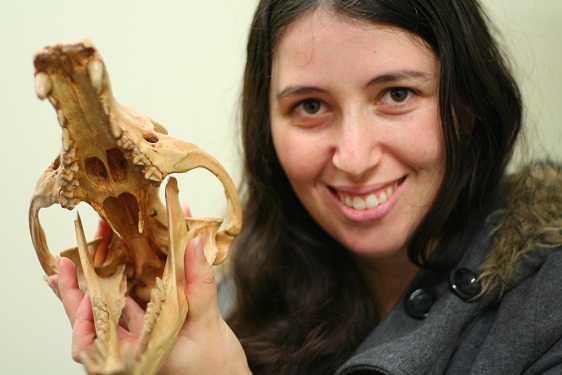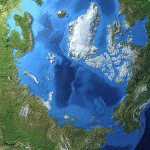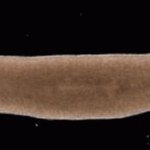
A 3D computer model of the thylacine skull, with areas of low (blue-green) and high (red-white) stress. Image: Marie Attard and Christopher Hammang

Marie Attard with the thylacine skull. Image: Marie Attard and Christopher Hammang
The thylacine’s weak jaws would have restricted it to small prey, according to a new study.
Thylacines once ranged across Australia and New Guinea, but were only found in Tasmania at the time of European settlement. The last known individual died at Hobart Zoo on September 7, 1936- just two months after the species received official protection from the Tasmanian Government.
The settlers placed a bounty on the thylacine, as it was supposedly killing sheep. However its jaws were so weak that it would have been restricted to hunting much smaller prey, according to researchers from the University of New South Wales (UNSW).
“It probably wouldn’t have been able to tackle such a large animal, like a sheep,” said doctoral student Marie Attard, lead author of the paper published today in the Journal of Zoology.
Using a thylacine skull and advanced computer modelling techniques, the research team simulated its hunting actions, such as biting, tearing and pulling. They then determined areas of stress in the skull, using the same software as engineers testing for weak spots in structures, and compared this to the skulls of a Tasmanian devil and a spotted-tailed quoll.
“The thylacine had a much higher level of stress in the skull,” said Ms Attard. “It pretty much lit up with high levels of stress.”
The stresses on the skull from the simulations of biting struggling prey enabled the researchers to predict the likely body size of the thylacine’s prey. In spite of the thylacine’s 30 kilogram body mass and carnivorous diet, its weak jaws limited it to small, agile prey, such as possums and bandicoots.
The thylacine’s inability to take large prey would have had serious implications for its survival, as this would have driven it into a specialised niche. On top of that, its teeth reveal that it was a hyper-carnivore and poorly adapted to eating bone, invertebrates or plants.
“What’s of interest (are) the broader implications,” said Dr Stephen Wroe, director of the Computational Biomechanics Research Group at UNSW. “In the advent of change, human-induced or otherwise, the thylacine didn’t really have much room to manoeuvre.”
The thylacine disappeared from the mainland 6000 years ago, around the time that dingoes were introduced to Australia approximately 6000 years ago by Indonesian seafarers. Other possible causes for its disappearance include climate change and changes in Aboriginal land use, which intensified at this time.
The arrival of European settlers in Tasmania and the subsequent loss of habitat and prey would have driven the thylacine closer to extinction. “Its range had been vastly reduced,” said Dr Wroe.
“The reality is when animals go extinct… it’s almost always more than one explanation and more than one contributing factor.”






